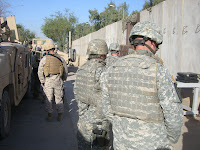Every day, a group of young JAGs, most of them younger than me, make this trek, and assume their "battle stations" within the court (which used to be the Museum of Saddam. There they present to the Investigating Judge (IJ) the evidence they have collected relating to detentions made by coalition forces. That is the extent of the role they play; interviewing witnesses (mainly soldiers, writing memos to the judge, playing the role not of prosecutor, but judicial liaison).



Iraq has a civil (continental, as opposed to common, or English) legal system, which means the IJ directs an inquisitorial process, questioning witnesses, evaluating other evidence, and then summarizing it for presentment to a trial panel of three judges. The IJ literally dictates his summary/findings to a scribe, who, by hand, takes it down, making copies with carbon paper. (One of the first dilemmas of the rule of law project here was finding carbon paper for the Iraqis to use because, of course, we haven't used it in years in the US.)



The investigative hearing I observed involved a weapons charge; a platoon of soldiers arrested a guy after they found a mortar launcher in his home, which home he acknowledged had been provided him by the JAM (the al-Mahdi militia). The judge took testimony of two soldiers, partially in English, partially with the aid of an interpreter, and then questioned the detainee. The JAG asked about one question per witness and the defense attorney opened her mouth but one time during the entire proceeding, and that was to ask one of the soldiers how he knew the mortar launcher was in good condition. "Because I'm a mortarman," the soldier replied with a grin. There's no way an American defense counsel would've asked that question.
The hearing took about an hour and a half, in what you could call an office (we sat on couches, the counsel and witnesses on chairs), and was interrupted a series of times by well-wishers and clerks of all sorts. Not so much chaotic -- the judge had things under control -- but bizarre. After it was over, the JAG told us that, if convicted, the detainee faced probably 10 years in prison. The detainee's sole argument is that the mortar was not his and he had no involvement with it -- even though he was living with it and knew it belonged to the JAM (itself a crime of sorts).
Then I went to the adjoining hall to witness a trial. Eight men in yellow jumpsuits were in the dock (literally, a wooden holding pen), as the chief judge read a summary of the evidence and briefly questioned several of the accused. Then the "prosecutor" (more a magistrate whose role is to make legal recommendations to the judges rather than urge conviction) had a chance to speak, and then the defense counsel. The men had been charged with a rather brutal kidnapping, as well as firing at coalition forces in a failed escape attempt. Interestingly, no evidence of the kidnapee (dead, alive, safe, or otherwise) had been presented. The proceedings took about 20 minutes, then judges deliberated for about 5 minutes.
Guilty! the chief judge pronounced, and sentenced each of the prisoners to life in jail. (We learned all these details after the court adjourned because there was no simultaneous translation.) The criminals did not react in the slightest, though I'm told that some of them kiss the ground and begin praying when acquitted. Note that neither the JAGs nor any other American/coalition forces played any role in the trial.
All in all, a fascinating morning.



No comments:
Post a Comment